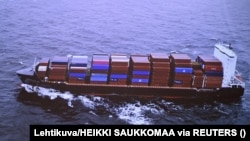A Chinese ship suspected of damaging an underwater gas pipeline and two telecom cables in the Baltic Sea is returning to China through the Russian Arctic as Finnish investigators continue to search for answers about the vessel’s role in the incident.
The Finnish National Bureau of Investigation (NBI) has led a probe into the October 8 damage to the Balticconnector pipeline that runs between Estonia and Finland and announced on October 20 that the Hong Kong-flagged NewNew Polar Bear container ship is the prime suspect, with its tracked location in the Baltic Sea coinciding with the time and place of the pipeline damage.
The NBI has since then said it believes the damage was caused by “an external force” that was “mechanical, not an explosion” and later revealed that a large anchor -- believed to belong to the 169-meter-long ship -- was found near the pipeline and likely broke off as it was dragged across the sea floor.
Investigators say it’s too early to determine whether the pipeline damage was sabotage or an accident, but the Finnish security intelligence agency said the involvement of a state actor “cannot be ruled out.”
The current mystery around the damaged Balticconnector pipeline and cables comes against the backdrop of past sabotage of underwater infrastructure in the Baltic Sea.
Amid rising tensions over Russia’s full-scale invasion of Ukraine, the Nord Stream 1 and 2 pipelines that brought gas from Russia to northern Germany were damaged by explosions.
Early theories highlighted potential Russian involvement and official investigations into the incident are ongoing, but leaked documents and U.S. intelligence reports obtained by The Washington Post have pointed toward potential saboteurs linked to Ukrainian intelligence. So, too, did an investigation by the German magazine Der Spiegel.
“As we have seen with Nord Stream, the investigation [into the Balticconnector pipeline] may take a long time,” Sari Arho Havren, an associate fellow at London's Royal United Services Institute, told RFE/RL. “In Finland's case, the investigation has been progressing very fast, and communication, especially by the National Bureau of Investigation, has indeed been incredibly open.”
Before Finland determined the involvement of the Chinese ship, Estonian investigators had announced they were also tracking the Sevmorput, a Russian vessel that was also within the area of the pipeline and cables when they were damaged. Experts say this has added to the peculiarities around the case and the list of potential motives and culprits.
“Whether this incident was intentional or not, it’s something that both Russia and China can benefit from,” said Arho Havren. “Even if the scale may be small, it once again diverts NATO’s attention and resources away from other global focal points.”
Russian authorities have denied any involvement in the incident and, on October 31, Finnish Prime Minister Petteri Orpo said China was cooperating with the investigation.
“We have opened diplomatic discussions with the Chinese and also have started cooperation with Chinese authorities. And they have promised…that they want to [cooperate],” he said.
An Evolving Investigation
Finnish investigators said they have tried several times to contact the Chinese ship’s captain but have been unsuccessful, adding they have asked Chinese officials for assistance.
Marine Traffic, a website that provides real-time information on the movement of ships around the world, showed that NewNew Polar Bear is sailing back to China through Russian waters on the Northern Sea Route, an Arctic shipping lane that stretches roughly from Murmansk in the west to the Bering Strait in the east.
As reported by the Independent Barents Observer, a newspaper based in the Norwegian Arctic, the vessel changed the name of its operator before entering the Northern Sea Route. NewNew Polar Bear was previously granted permission to cross the waters with the operator Hainan Xin Xin Yang Shipping, but an updated document shows the ship is now tied to Torgmoll, a Russian-registered company with offices in Moscow and Shanghai.
Frank Juris, a researcher at Tallinn University, told RFE/RL that “the man-made damage to critical infrastructure at NATO’s eastern flank with Chinese and Russia affiliated vessels in close proximity” does raise the prospect of potential “coordination and cooperation between China and Russia,” but that the continued investigation by Finnish law enforcement will determine the true cause.
As Finnish authorities enter the next phase of their investigation, photos have been shared online by the Russian website Port News that appear to show the Chinese vessel without one of its anchors. The October 9 photos show the ship at port in St. Petersburg -- one day after the pipeline was damaged.
The images then circulated online and were published by Yle, the Finnish national broadcaster, appearing to show one of the ship’s anchors missing.
Mikko Heikkila, an experienced sea captain who has analyzed the photos for Yle, said that, if such an anchor were to be lowered accidentally, it is unlikely it would be unnoticed by the ship’s crew.
Lowering the bow anchor on cargo ships like the NewNew Polar Bear, he said, usually must be done manually from the bow of the ship and the process has several safeguards in place to prevent accidents from occurring.
Heikkila added that, if the ship was intentionally trying to damage the pipeline with the anchor, then doing so would be a slow, time-consuming, and risky process that would require stopping the ship.
The Finnish daily Helsingin Sanomat reported that the NewNew Polar Bear came to a halt shortly before crossing the underwater gas pipeline.
Accident Or Sabotage?
The evolving case has put Finland and its neighbors on alert.
The Nordic country joined NATO earlier this year in the wake of Russia’s full-scale invasion of Ukraine and the transatlantic military alliance has pledged a “united and determined response” if the Balticconnector pipeline damage is determined to have been sabotage.
NATO Secretary-General Jens Stoltenberg said on October 24 that the alliance’s members had “tens of thousands of kilometers” of submarine Internet cables, power cables, and pipelines from the Baltic to the Mediterranean at risk.
“Of course, these types of undersea critical infrastructure are vulnerable,” Stoltenberg said, adding that NATO has stepped up patrols in the Baltic and is currently working with the private sector, which “owns most of this critical infrastructure” to better coordinate a response.
The $318 million, 77-kilometer pipeline that connects Finland to the European gas network was launched for commercial use at the beginning of 2020. Balticconnector’s operators have said it will take at least five months to repair the pipeline and it is unlikely to come onstream before April.
The damage to the pipeline is unlikely to affect Finland’s energy security, however. The country currently only relies on natural gas for 5 percent of its energy supplies, with a growing reliance on renewables and nuclear power, as well as a recently opened liquefied natural gas (LNG) terminal.
“Whether [at] the end of the day intentional sabotage can be proved or not, this case will at a minimum raise Finland’s preparedness for similar operations in the future,” Arho Havren said.



